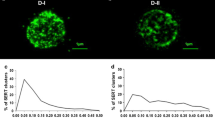Abstract
Based on recent studies of neuroimmune networks, the lymphocyte binding of serotonin neurotransmitter was studied in patients with Alzheimer’s disease, idiopathic mental retardation, and autism. The specific binding to lymphocytes of [3H]serotonin, at a single concentration of 100 nM, was significantly reduced in Alzheimer’s disease patients as compared to aged controls (group mean of 3.667 ± 2.301 v 7.506 ± 1.717 picomoles;p=0.001), and in children with idiopathic mental retardation as compared to healthy children (group mean of 3.694±1.627 v 5.792±1.902 picomoles;p=0.003).
However, autistic children did not differ significantly from the healthy children (group mean of 5.287±1.987 v 5.792±1.902 picomoles;p=0.475). Reduced lymphocyte binding of serotonin may be an indication of breakdown of an unknown neuroimmune pathway relevant to the pathophysiology of Alzheimer’s disease and idiopathic mental retardation.
Similar content being viewed by others
References
Bartha E., Szelenji K., Szilagji K., Venter V., Thu Ha N. T., Paldi-Harris P., and Hollan S. (1987) Altered lymphocyte acetylcholinesterase in patients with senile dementia.Neurosci. Lett. 79, 190–194.
Bonnet M., Lespinats G., and Burtin C. (1984) Histamine and serotonin suppression of lymphocyte response to phytohemagglutinin and allogeneic cells.Cell. Immunol. 83, 280–291.
Bonnet M., Lespinats G., and Burtin C. (1988) Evidence for serotonin (5-HT) binding sites on murine lymphocytes.Int. J. Pharmacol. 9, 551–558.
Bowen D. M. and Davison A. N. (1986) Biochemical studies of nerve cells and energy metabolism in Alzheimer’s disease.Br. Med. Bull. 42, 75–80.
Gibson G. E., Nielson P., Sherman K. A., and Blass J. P. (1987) Diminished mitogen-induced calcium uptake by lymphocytes from Alzheimer’s patients.Biol. Psychiatr 22, 1079–1086.
Grossman H. J. (1983)Classification in Mental Retardation, Chap. 5, pp. 59–77, American Association on Mental Deficiency Publ., Washington, D. C.
Heston L. L. and White J. A. (1983)Dementia: A Practical Guide to Alzheimer’s Disease and Related Illnesses, Chap. 2, pp. 11–23, W. H. Freeman and Co., New York, N.Y.
Jackson J. C., Cross R. J., Walker R. F., Markesbery W. R., Brooks W. H., and Roszman, T. L. (1985) Influence of serotonin on the immune response.Immunology 54, 505–512.
Martelleti P., Alteri E., Pesce A., Rinaldi-Garaci C., and Giacovazzo M. (1988) In vitro interactions of serotonin (5-HT) with mononuclear cells from migraine patients: Alterations related to the phase of the attack.J. Neuroimmunol. 18, 17–24.
Rossor M. and Iversen L. L. (1986) Noncholinergic neurotransmitter abnormalities in Alzheimer’s disease.Br. Med. Bull. 42, 70–74.
Schmidt A. W. and Peroutka S. J. (1989) 5-Hydroxytryptamine receptor “families”.FASEB J. 3, 2242–2249.
Singh V. K. (1990) Neuroimmune axis as a basis of therapy in Alzheimer’s disease.Prog. Drug Res. 34, 383–393.
Singh V. K. and Fudenberg H. H. (1988) Binding of [125I] corticotropin releasing factor to blood immunocytes and its reduction in Alzheimer’s disease.Immunol. Lett. 18, 5–8.
Singh V. K., Fudenberg H. H., and Brown F. R. (III) (1987) Immunologic dysfunction: Simultaneous study of Alzheimer’s and Down’s patients.Mech. Ageing Develop. 37, 257–264.
Singh V. K. and Warren R. P. (1989) Immunologic approach to therapy in Alzheimer’s disease, inNovel Approaches to the Treatment of Alzheimer’s Disease (Meyer E. M., Simpkins J. W., and Yamamoto J., eds.), pp. 213–220, Plenum, New York, N.Y.
Slauson D. O., Walker C., Kristensen F., Wang Y., and De Weck, A. L. (1984) Mechanism of serotonin-induced lymphocyte proliferation inhibition.Cell. Immunol. 84, 240–252.
Solomon G. F. (1987) Psychoneuroimmunology: interactions between central nervous system and immune system.J. Neurosci. Res. 18, 1–9.
Warren R. P., Kane K. K., Burger R. A., and Singh V. K. (1990) Serotonin-induced suppression of lymphocyte DNA synthesis and NK cell activity.Ann. N.Y. Acad. Sci. 594, 429–431.
Wisniewski K. E., Wisniewski H. M., and Wen G. Y. (1985) Occurrence of neuropathological changes and dementia of Alzheimer’s disease in Down’s syndrome.Ann. Neurol. 17, 278–282.
Zubenko G. S., Wusylko M., Cohen B. M., Boller F., and Teply I. (1987) Family study of platelet membrane fluidity in Alzheimer’s disease.Science 238, 539–542.
Author information
Authors and Affiliations
Rights and permissions
About this article
Cite this article
Singh, V.K., Warren, R.P. & Singh, E.A. Binding of [3H]serotonin to lymphocytes in patients with neuropsychiatric disorders. Molecular and Chemical Neuropathology 13, 167–173 (1990). https://doi.org/10.1007/BF03159919
Received:
Accepted:
Issue Date:
DOI: https://doi.org/10.1007/BF03159919




